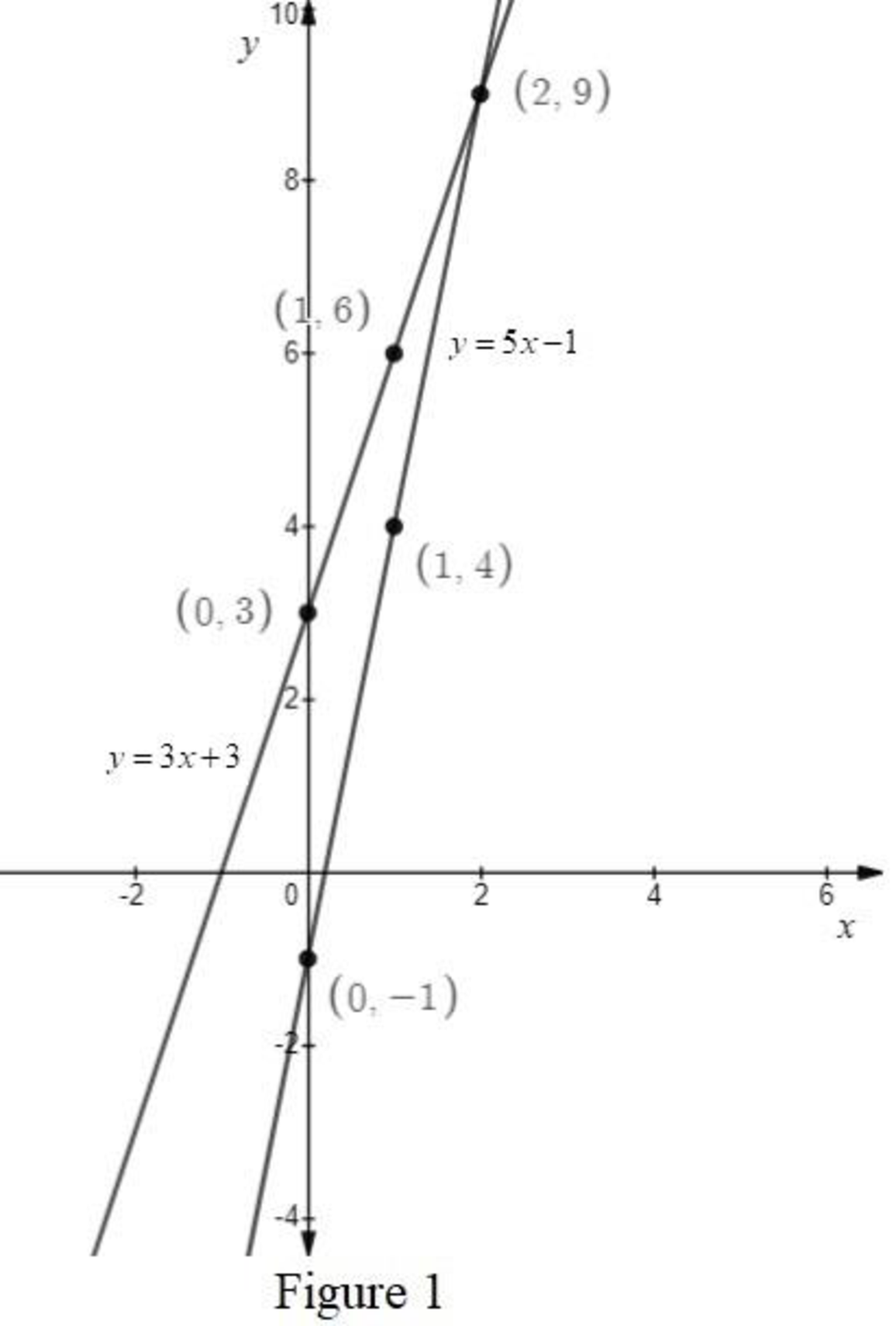
The solution of the system of equations
Answer to Problem 1RE
The solution of the system of equations
Explanation of Solution
Given:
The system of equations are
Procedure used:
To solve a system of two equations on the same pair of axes:
1. Graph each equation on the same pair of axes.
2. The solution will be the common point.
Calculation:
Obtain the solution of the system of equations
Assume values for the variable x and obtain the values for the variable y for the equation
| x | ||
| 2 | 9 | |
| 1 | 4 | |
| 0 | –1 |
Table 1
Similarly, assume values for the variable x and obtain the values for the variable y for the equation
| x | ||
| 2 | 9 | |
| 1 | 6 | |
| 0 | 3 |
Table 2
Graph each equation on the same set of axes by the use of the co-ordinate values from Table 1 and Table 2 as shown in the below figure.

From Figure 1, it is observed that the two graphs intersect at
Thus, the solution of the system of equations is
Check whether the solution is correct by substituting the solution
Thus, the solution
Similarly, substitute the solution
Thus, the solution
Want to see more full solutions like this?
Chapter 10 Solutions
MML F/COLLEGE MAT F/TRADES - ACCESS CODE
- 7. 11 m 12.7 m 14 m S V=B₁+ B2(h) 9.5 m 16 m h+s 2 na 62-19 = 37 +, M h² = Bu-29arrow_forwardFind the interval and radius of convergence for the given power series. n=0 (− 1)" xn 7" (n² + 2) The series is convergent on the interval: The radius of convergence is R =arrow_forwardFind the interval and radius of convergence for the given power series. n=1 (x-4)" n( - 8)" The series is convergent on the interval: The radius of convergence is R =arrow_forward
- Find the interval and radius of convergence for the given power series. n=0 10"x" 7(n!) The series is convergent on the interval: The radius of convergence is R =arrow_forwardwhat would a of a interscribed angle be with an arc of 93 degrees and inside abgles of 111 and 98arrow_forwardFrom a sample of 26 graduate students, the mean number of months of work experience prior to entering an MBA program was 34.67. The national standard deviation is known to be18 months. What is a 90% confidence interval for the population mean? Question content area bottom Part 1 A 9090% confidence interval for the population mean is left bracket nothing comma nothing right bracketenter your response here,enter your response here. (Use ascending order. Round to two decimal places as needed.)arrow_forward
- A person leaves home and walks 3 miles west, then 4 miles southwest. How far from home is she? miles In what direction must she walk to head directly home? degrees North of East Question Help: Video Submit Question Jump to Answerarrow_forwardwhats this answer Ginger records her grades for each assignment in science.arrow_forwardConsider the electrical circuit shown in Figure P6-41. It consists of two closed loops. Taking the indicated directions of the currents as positive, obtain the differential equations governing the currents I1 and I2 flowing through the resistor R and inductor L, respectively.arrow_forward
- Solve the following initial value problem the initial conditions aw +3. = 12z+18 +9, Əz2 მი w(x, 0)=2x3+3x²+8x ду From (38) auction we obtain follow (x, 0) =i (6x²-6x+2).arrow_forwardCalculus lll May I please have the semicolon statements in the boxes explained and completed? Thank you so mucharrow_forwardSolve the following systems of equations and show all work.y = x2 + 3y = x + 5 Please type out answerarrow_forward
 Discrete Mathematics and Its Applications ( 8th I...MathISBN:9781259676512Author:Kenneth H RosenPublisher:McGraw-Hill Education
Discrete Mathematics and Its Applications ( 8th I...MathISBN:9781259676512Author:Kenneth H RosenPublisher:McGraw-Hill Education Mathematics for Elementary Teachers with Activiti...MathISBN:9780134392790Author:Beckmann, SybillaPublisher:PEARSON
Mathematics for Elementary Teachers with Activiti...MathISBN:9780134392790Author:Beckmann, SybillaPublisher:PEARSON
 Thinking Mathematically (7th Edition)MathISBN:9780134683713Author:Robert F. BlitzerPublisher:PEARSON
Thinking Mathematically (7th Edition)MathISBN:9780134683713Author:Robert F. BlitzerPublisher:PEARSON Discrete Mathematics With ApplicationsMathISBN:9781337694193Author:EPP, Susanna S.Publisher:Cengage Learning,
Discrete Mathematics With ApplicationsMathISBN:9781337694193Author:EPP, Susanna S.Publisher:Cengage Learning, Pathways To Math Literacy (looseleaf)MathISBN:9781259985607Author:David Sobecki Professor, Brian A. MercerPublisher:McGraw-Hill Education
Pathways To Math Literacy (looseleaf)MathISBN:9781259985607Author:David Sobecki Professor, Brian A. MercerPublisher:McGraw-Hill Education





